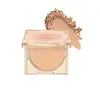What's inside
What's inside
 Key Ingredients
Key Ingredients

 Benefits
Benefits

 Concerns
Concerns

 Ingredients Side-by-side
Ingredients Side-by-side

Talc
AbrasiveTitanium Dioxide
Cosmetic ColorantSilica
AbrasiveEthylhexyl Methoxycinnamate
UV AbsorberNylon-12
Octyldodecanol
EmollientTriethylhexanoin
MaskingZinc Oxide
Cosmetic ColorantPCA Dimethicone
Skin ConditioningPhenoxyethanol
PreservativeHydrogen Dimethicone
Zinc Gluconate
Skin ConditioningDimethicone
EmollientEthylhexylglycerin
Skin ConditioningTriethoxycaprylylsilane
Aluminum Hydroxide
EmollientHdi/Trimethylol Hexyllactone Crosspolymer
Polymethyl Methacrylate
Dimethiconol Stearate
EmollientMethicone
EmollientParfum
MaskingNiacinamide
SmoothingTocopheryl Acetate
AntioxidantBHT
AntioxidantTocopherol
AntioxidantGlycyrrhiza Glabra Root Extract
BleachingCI 77492
Cosmetic ColorantCI 77491
Cosmetic ColorantCI 77499
Cosmetic ColorantCI 77288
Cosmetic ColorantCI 42090
Cosmetic ColorantTalc, Titanium Dioxide, Silica, Ethylhexyl Methoxycinnamate, Nylon-12, Octyldodecanol, Triethylhexanoin, Zinc Oxide, PCA Dimethicone, Phenoxyethanol, Hydrogen Dimethicone, Zinc Gluconate, Dimethicone, Ethylhexylglycerin, Triethoxycaprylylsilane, Aluminum Hydroxide, Hdi/Trimethylol Hexyllactone Crosspolymer, Polymethyl Methacrylate, Dimethiconol Stearate, Methicone, Parfum, Niacinamide, Tocopheryl Acetate, BHT, Tocopherol, Glycyrrhiza Glabra Root Extract, CI 77492, CI 77491, CI 77499, CI 77288, CI 42090
Talc
AbrasiveMica
Cosmetic ColorantSilica
AbrasiveCaprylic/Capric Triglyceride
MaskingNylon-12
Magnesium Myristate
Phenyl Trimethicone
Skin ConditioningKaolin
AbrasiveEctoin
Skin ConditioningEthylhexyl Methoxycinnamate
UV AbsorberTocopherol
AntioxidantAscorbic Acid
AntioxidantSqualane
EmollientCeramide 1
Skin ConditioningDiisostearyl Malate
EmollientPhenoxyethanol
PreservativeIngredients Explained
These ingredients are found in both products.
Ingredients higher up in an ingredient list are typically present in a larger amount.
Ethylhexyl Methoxycinnamate is an organic compound that provides UVB protection. It often goes by the more common name of octinoxate. It is created from methoxycinnamic acid and 2-ethylhexanol.
Ethylhexyl Methoxycinnamate absorbs UVB rays with wavelengths between 280-320 nm. UV absorbers protect your skin by using chemical reactions to convert UV rays into heat and energy.
UVB (290-320 nm) rays emit more energy than UVA rays. They are capable of damaging DNA, causing sunburns and are thought to be linked to skin cancer.
The state of Hawaii has banned sunscreens containing octinoxate due to its potential impact on coral reefs. More research is needed to bridge gaps in this research. The European Union allows higher levels of octinoxate in sunscreens than the US and Australia.
Ethylhexyl Methoxycinnamate is oil soluble. It is not stable and may lose efficacy when exposed to sunlight.
Learn more about Ethylhexyl MethoxycinnamateNylon-12 is a polymer. It is derived from 12-aminododecanoic acid, an omega-amino fatty acid
According to a manufacturer, it is a talc substitute. Like talc, nylon-12 gives products a satin feel. The manufacturer also claims this ingredients does not block pores and has moderate oil absorption.
This ingredient may not be reef-safe.
Learn more about Nylon-12Phenoxyethanol is a preservative that has germicide, antimicrobial, and aromatic properties. Studies show that phenoxyethanol can prevent microbial growth. By itself, it has a scent that is similar to that of a rose.
It's often used in formulations along with Caprylyl Glycol to preserve the shelf life of products.
Silica, also known as silicon dioxide, is a naturally occurring mineral. It is used as a fine, spherical, and porous powder in cosmetics.
Though it has exfoliant properties, the function of silica varies depending on the product.
The unique structure of silica enhances the spreadability and adds smoothness, making it a great texture enhancer.
It is also used as an active carrier, emulsifier, and mattifier due to its ability to absorb excess oil.
In some products, tiny microneedles called spicules are made from silica or hydrolyzed sponge. When you rub them in, they lightly polish away dead skin layers and enhance the penetration of active ingredients.
Learn more about SilicaTalc is a clay mineral. It helps absorb moisture and improve the texture of products. Like other types of clay, Talc can have a slight exfoliating effect on skin. Talc can be added to increase the volume of products.
Some Baby powders are made by combining talc with corn starch. The word "talc" comes from Latin and originates from Arabic. Talc is a mineral commonly found throughout the world.
If you have any concerns about using talc, we recommend checking out the FDA's official page.
Learn more about TalcTocopherol (also known as Vitamin E) is a common antioxidant used to help protect the skin from free-radicals and strengthen the skin barrier. It's also fat soluble - this means our skin is great at absorbing it.
Vitamin E also helps keep your natural skin lipids healthy. Your lipid skin barrier naturally consists of lipids, ceramides, and fatty acids. Vitamin E offers extra protection for your skin’s lipid barrier, keeping your skin healthy and nourished.
Another benefit is a bit of UV protection. Vitamin E helps reduce the damage caused by UVB rays. (It should not replace your sunscreen). Combining it with Vitamin C can decrease sunburned cells and hyperpigmentation after UV exposure.
You might have noticed Vitamin E + C often paired together. This is because it is great at stabilizing Vitamin C. Using the two together helps increase the effectiveness of both ingredients.
There are often claims that Vitamin E can reduce/prevent scarring, but these claims haven't been confirmed by scientific research.
Learn more about Tocopherol